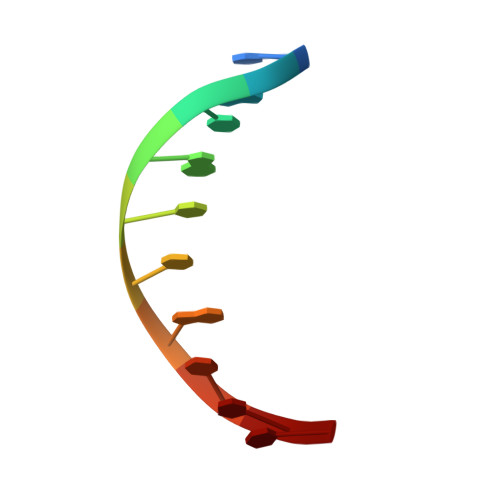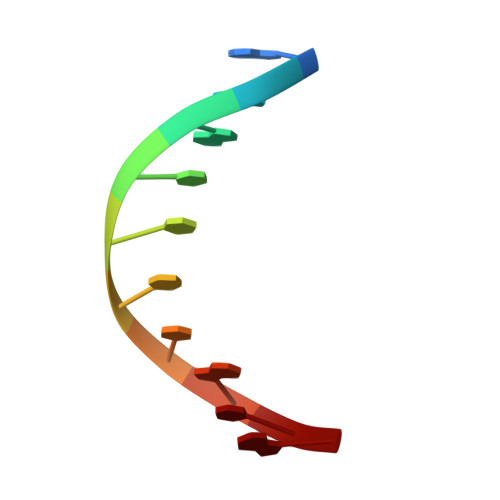The structure of metallo-DNA with consecutive thymine-HgII-thymine base pairs explains positive entropy for the metallo base pair formation.
Yamaguchi, H., Sebera, J., Kondo, J., Oda, S., Komuro, T., Kawamura, T., Dairaku, T., Kondo, Y., Okamoto, I., Ono, A., Burda, J.V., Kojima, C., Sychrovsky, V., Tanaka, Y.(2014) Nucleic Acids Res 42: 4094-4099
- PubMed: 24371287
- DOI: https://doi.org/10.1093/nar/gkt1344
- Primary Citation of Related Structures:
2RT8 - PubMed Abstract:
We have determined the three-dimensional (3D) structure of DNA duplex that includes tandem Hg(II)-mediated T-T base pairs (thymine-Hg(II)-thymine, T-Hg(II)-T) with NMR spectroscopy in solution. This is the first 3D structure of metallo-DNA (covalently metallated DNA) composed exclusively of 'NATURAL' bases. The T-Hg(II)-T base pairs whose chemical structure was determined with the (15)N NMR spectroscopy were well accommodated in a B-form double helix, mimicking normal Watson-Crick base pairs. The Hg atoms aligned along DNA helical axis were shielded from the bulk water. The complete dehydration of Hg atoms inside DNA explained the positive reaction entropy (ΔS) for the T-Hg(II)-T base pair formation. The positive ΔS value arises owing to the Hg(II) dehydration, which was approved with the 3D structure. The 3D structure explained extraordinary affinity of thymine towards Hg(II) and revealed arrangement of T-Hg(II)-T base pairs in metallo-DNA.
Organizational Affiliation:
Laboratory of Molecular Transformation, Graduate School of Pharmaceutical Sciences, Tohoku University, 6-3 Aza-Aoba, Aramaki, Aoba-ku, Sendai, Miyagi 980-8578, Japan, Institute of Organic Chemistry and Biochemistry, Academy of Sciences of the Czech Republic, Flemingovo nám. 2, 166 10, Praha 6, Czech Republic, Department of Materials and Life Sciences, Faculty of Science and Technology, Sophia University, 7-1 Kioicho, Chiyoda-ku, Tokyo 102-8554, Japan, Department of Material and Life Chemistry, Faculty of Engineering, Kanagawa University, 3-27-1 Rokkakubashi, Kanagawa-ku, Yokohama, Kanagawa 221-8686 Japan, Department of Chemical Physics and Optics, Faculty of Mathematics and Physics, Charles University in Prague, Ke Karlovu 3, 121 16 Prague 2, Czech Republic and Institute for Protein Research, Osaka University, 3-2 Yamadaoka, Suita, Osaka 565-0871, Japan.
















